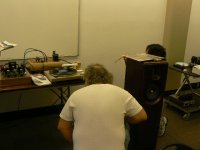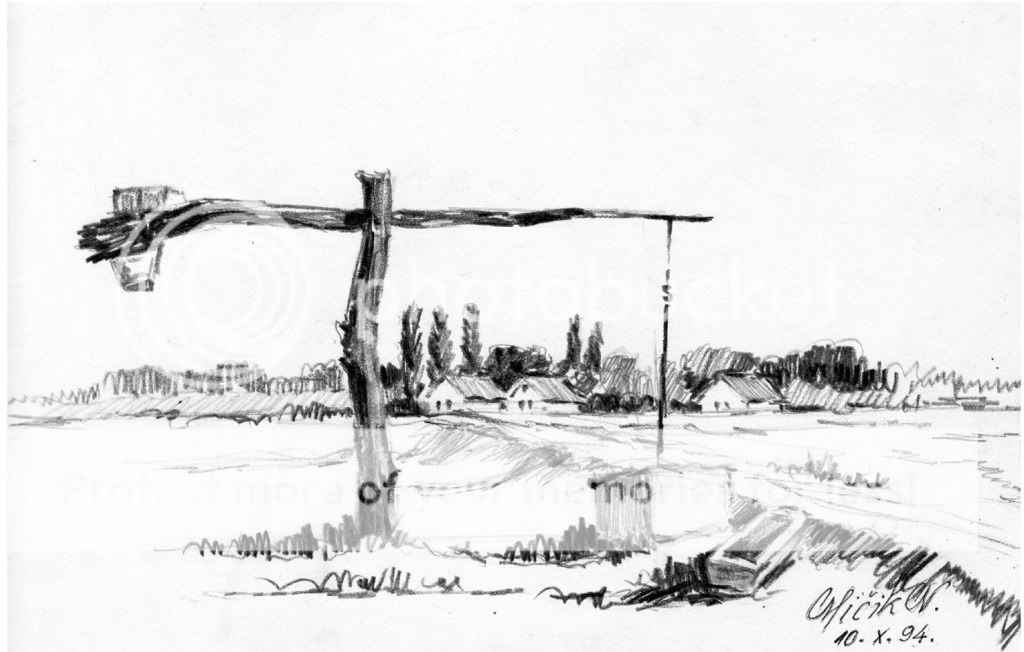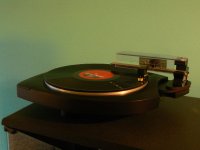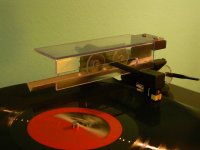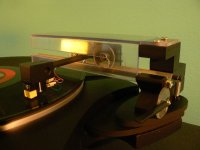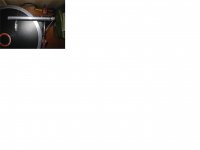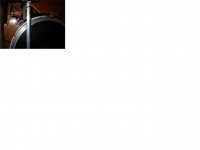I took my Cantus clone to the Burning Amp Festival this year and it got intense attention all afternoon. That record was eccentric and people were fascinated watching the arm move back and forth and not skip. Despite that, I don't think anybody else decided to build one and I don't quite understand that. Mine is crude and ugly - maybe that puts would-be builders off. But, as Robin' arm shows, they can successfully and attractively be built with hand tools and easily available cheap hardware. Even good bearings aren't expensive. Robin's long bolt for the tower solves a whole bunch of set up variables all at once.
And when the arm is built, it produces great music.
I have a couple of questions: Has anybody checked records that have been played repeatedly with passive linear trackers with a microscope to see if there is abnormal wear, especially on the rim side of the groove and the same with the stylus? The whole passive LT thing is so easy, it seems too much like a free lunch. The second question is which level of stylus compliance seems to work best? I had a third question about optimum arm geometry, but Moray's already covered that.
And a couple of observations: I think discussions about resonance sometimes seem to conflate two properties - the inherent tendency of an object to ring at a particular frequency based on the material and its size,weight, and shape - with the tendency of an object to transmit an induced vibration. And until Robin posted, I hadn't considered the air column in the tube. I used drop and flick tests to choose materials and combinations which seemed to have the least resonance and a mechanic's stethoscope to check the induced vibrations. I was amazed and dismayed at the amount of music being transmitted through the arm from the stylus. Eventually, using Moray's suggestion of heat shrink on the arm quieted things down.
And when the arm is built, it produces great music.
I have a couple of questions: Has anybody checked records that have been played repeatedly with passive linear trackers with a microscope to see if there is abnormal wear, especially on the rim side of the groove and the same with the stylus? The whole passive LT thing is so easy, it seems too much like a free lunch. The second question is which level of stylus compliance seems to work best? I had a third question about optimum arm geometry, but Moray's already covered that.
And a couple of observations: I think discussions about resonance sometimes seem to conflate two properties - the inherent tendency of an object to ring at a particular frequency based on the material and its size,weight, and shape - with the tendency of an object to transmit an induced vibration. And until Robin posted, I hadn't considered the air column in the tube. I used drop and flick tests to choose materials and combinations which seemed to have the least resonance and a mechanic's stethoscope to check the induced vibrations. I was amazed and dismayed at the amount of music being transmitted through the arm from the stylus. Eventually, using Moray's suggestion of heat shrink on the arm quieted things down.
Attachments
been a long time away....
guys: the arms look great and (apparently) sound great too.
Been away (or at least very sporadically posting), due to 2 HD crashes and a leaky basement. Any bigger pictures available of the builds? Could a thread for pictures/plans or a photo album created?
moray:I haven't forgotten about Bob's table. I did discover that the arm we made when you were last down was troubled by the preamp, not the tonearm wiring. I plan on redoing that arm and presenting it to Bob as a gift. Please email me with some more info about your brother's table. Have you been able to get the tables/arms to work suitably to get your $$$s out of them?
guys: the arms look great and (apparently) sound great too.
Been away (or at least very sporadically posting), due to 2 HD crashes and a leaky basement. Any bigger pictures available of the builds? Could a thread for pictures/plans or a photo album created?
moray:I haven't forgotten about Bob's table. I did discover that the arm we made when you were last down was troubled by the preamp, not the tonearm wiring. I plan on redoing that arm and presenting it to Bob as a gift. Please email me with some more info about your brother's table. Have you been able to get the tables/arms to work suitably to get your $$$s out of them?
Hi Doug,
people in the record industry always said that the vinyl compresses during play and then returns to its original shape in time. Wear only occurs when there is mistracking (mostly due to too little VTF), worn stylus or dirt in the groove that the stylus drags along. If we think about it, conventional tone arms have bearings with "finite" resistance too. The stylus would have to cause the same problems even if there was an antiskate function.
I have tried 2 cartridges in my arm. A vintage Ortofon MC30 (never sounded better) and a high compliance Luxman MC. Both work well with off center or warped records. I think that this design has less preference because it has a completely different resonant behavior. The inherent stiffness is a big asset here as is the solid contact with 4 bearing points.
There is no free lunch. The tube over the record is a pain, keeping the tube clean in a smoking environment is probably an issue. There are also a lot of pseudo arguments by experts that have never tried this method - 4 ball bearing contact points, short arm and fantasy issues that people with the arm simply never experience. The only issue that I had was my own ignorance. The bearings have to be free of lubricant and that means high quality otherwise you get chatter. I have a couple of hard drives that I am going to crack open. There are usually very high quality bearings on those platters.......
@Nanook: If there is a specific picture or measurement that you are looking for, I would be happy to post it or mail it to you. I laid this complete project out on a piece of paper on the turntable in about 20 minutes. Bosse Hansson really did the vinyl lover a great service with this invention.
people in the record industry always said that the vinyl compresses during play and then returns to its original shape in time. Wear only occurs when there is mistracking (mostly due to too little VTF), worn stylus or dirt in the groove that the stylus drags along. If we think about it, conventional tone arms have bearings with "finite" resistance too. The stylus would have to cause the same problems even if there was an antiskate function.
I have tried 2 cartridges in my arm. A vintage Ortofon MC30 (never sounded better) and a high compliance Luxman MC. Both work well with off center or warped records. I think that this design has less preference because it has a completely different resonant behavior. The inherent stiffness is a big asset here as is the solid contact with 4 bearing points.
There is no free lunch. The tube over the record is a pain, keeping the tube clean in a smoking environment is probably an issue. There are also a lot of pseudo arguments by experts that have never tried this method - 4 ball bearing contact points, short arm and fantasy issues that people with the arm simply never experience. The only issue that I had was my own ignorance. The bearings have to be free of lubricant and that means high quality otherwise you get chatter. I have a couple of hard drives that I am going to crack open. There are usually very high quality bearings on those platters.......
@Nanook: If there is a specific picture or measurement that you are looking for, I would be happy to post it or mail it to you. I laid this complete project out on a piece of paper on the turntable in about 20 minutes. Bosse Hansson really did the vinyl lover a great service with this invention.
Last edited:
Simple arm
Nanook say that he like a simple arm. Mee too
Nanook say that he like a simple arm. Mee too
An externally hosted image should be here but it was not working when we last tested it.
most recent
Good morning,
This is my latest LT. I made some concessions to appearance with this one. The cover is from a broken TT lid with the arm lift/rest built in. The tower is hinged at the back for arm lift. There's a registration pin between the upper and lower halves for alignment and the spring compensates for the torque caused by the additional weight of the cover so things stay level. I finally figured out how to work acrylic, so naturally I went overboard.
This is the first LT I've built that I can fairly confidently measure VTF on and it tracks very well at Shure's recommended maximum 1.5 grams for the M91ED, although it may have sounded better at about 2.5 grams. I played a record that is both eccentric and warped so the arm was doing cycloids all the way across - it looked drunk, but no skips and the stylus stayed centered.
OK, I'm going to bang the DIY drum, again. Despite the focus on appearance this time, except for the bearings, this arm was built with scrounged materials, in a relatively limited shop. A basic arm can be made with hand tools and the result and reward can far exceed the effort.
Good morning,
This is my latest LT. I made some concessions to appearance with this one. The cover is from a broken TT lid with the arm lift/rest built in. The tower is hinged at the back for arm lift. There's a registration pin between the upper and lower halves for alignment and the spring compensates for the torque caused by the additional weight of the cover so things stay level. I finally figured out how to work acrylic, so naturally I went overboard.
This is the first LT I've built that I can fairly confidently measure VTF on and it tracks very well at Shure's recommended maximum 1.5 grams for the M91ED, although it may have sounded better at about 2.5 grams. I played a record that is both eccentric and warped so the arm was doing cycloids all the way across - it looked drunk, but no skips and the stylus stayed centered.
OK, I'm going to bang the DIY drum, again. Despite the focus on appearance this time, except for the bearings, this arm was built with scrounged materials, in a relatively limited shop. A basic arm can be made with hand tools and the result and reward can far exceed the effort.
Attachments
Thanks Stew,
I built the plinth a while back. The platter is from an AR corpse and the motor from a BIC. The 3D geometry challenges involved in matching the new arm to the plinth were the hardest I hit on this project.
A friend mentioned the Marantz SLT-12. I googled it and, since I've gone to the dark side of complication, instead of sticking with the simplicity of the Cantus - and your 219 - I think I've found my next project.
The SLT-12 is beautifully engineered and the innards are almost sculptural, but I can't help wondering why Saul thought it had to be designed that way - and what he knew that I don't.
I built the plinth a while back. The platter is from an AR corpse and the motor from a BIC. The 3D geometry challenges involved in matching the new arm to the plinth were the hardest I hit on this project.
A friend mentioned the Marantz SLT-12. I googled it and, since I've gone to the dark side of complication, instead of sticking with the simplicity of the Cantus - and your 219 - I think I've found my next project.
The SLT-12 is beautifully engineered and the innards are almost sculptural, but I can't help wondering why Saul thought it had to be designed that way - and what he knew that I don't.
I did a bearing comparison last weekend. The original bearings that I used for the project had ceramic balls in a stainless frame. They had quite a bit of play after flushing the grease. I ordered several different types by mailorder and here is what I found:
The lowest friction were the glass balls in a plastic casing. The sound was dull, a lot less bass and definition compared to the ceramic bearings. I then tried a standard bearing with a teflon cover. The cover seemed to increase the friction, I could see the cantilever flexing laterally. The sound was OK though. After removing the cover, the flexing went away, the sound was still OK, just not as good as the ceramic bearings. The final comparison were chrome steel bearings from SKF. These things are incredible - even better than the ceramic. Soprano voices had less stridency, the bass was still powerful and clear. No noticable cantilever flexing.
I put a USB connector/jack on the RCA end of the cable. This allows me to remove the arm wand/wire for cleaning or protection from my wifes dustcloth.................
Again, a very easy project that simply sounds great!
The lowest friction were the glass balls in a plastic casing. The sound was dull, a lot less bass and definition compared to the ceramic bearings. I then tried a standard bearing with a teflon cover. The cover seemed to increase the friction, I could see the cantilever flexing laterally. The sound was OK though. After removing the cover, the flexing went away, the sound was still OK, just not as good as the ceramic bearings. The final comparison were chrome steel bearings from SKF. These things are incredible - even better than the ceramic. Soprano voices had less stridency, the bass was still powerful and clear. No noticable cantilever flexing.
I put a USB connector/jack on the RCA end of the cable. This allows me to remove the arm wand/wire for cleaning or protection from my wifes dustcloth.................
Again, a very easy project that simply sounds great!
Attachments
Good morning,
This is my latest LT. I made some concessions to appearance with this one. The cover is from a broken TT lid with the arm lift/rest built in. The tower is hinged at the back for arm lift. There's a registration pin between the upper and lower halves for alignment and the spring compensates for the torque caused by the additional weight of the cover so things stay level. I finally figured out how to work acrylic, so naturally I went overboard.
This is the first LT I've built that I can fairly confidently measure VTF on and it tracks very well at Shure's recommended maximum 1.5 grams for the M91ED, although it may have sounded better at about 2.5 grams. I played a record that is both eccentric and warped so the arm was doing cycloids all the way across - it looked drunk, but no skips and the stylus stayed centered.
OK, I'm going to bang the DIY drum, again. Despite the focus on appearance this time, except for the bearings, this arm was built with scrounged materials, in a relatively limited shop. A basic arm can be made with hand tools and the result and reward can far exceed the effort.
This looks really cool!
My experiments with the Cantus type geometry show that mechanical grounding really helps the sound. Could you try a glass or hard metal disc instead of plastic?
Some pictures of the rare Nottingham Paragon linear tracker.
.
An externally hosted image should be here but it was not working when we last tested it.
An externally hosted image should be here but it was not working when we last tested it.
.
Hi, can i partecipate in this thread? 
My recipe:
- 1 acrylic tube, 20mm diameter, hole with Dremel
- 2 bearings given from a CPU fan coil, 8mm diameter
- arm from a piece of alluminium, U section
Seldom the pickup jump out of the groove, I'm looking for a dry teflon spray to decrease the friction. Has anyone ever tried a ptfe spray inside the tube?
This tonearmarm is amazing, it sound without distorction, I love it!
bye
Nando
My recipe:
- 1 acrylic tube, 20mm diameter, hole with Dremel
- 2 bearings given from a CPU fan coil, 8mm diameter
- arm from a piece of alluminium, U section
An externally hosted image should be here but it was not working when we last tested it.
An externally hosted image should be here but it was not working when we last tested it.
An externally hosted image should be here but it was not working when we last tested it.
An externally hosted image should be here but it was not working when we last tested it.
Seldom the pickup jump out of the groove, I'm looking for a dry teflon spray to decrease the friction. Has anyone ever tried a ptfe spray inside the tube?
This tonearmarm is amazing, it sound without distorction, I love it!
bye
Nando
Nando,
Welcome to the thread and thank you for posting. There was lots of speculation about acrylic tubes earlier in the thread. Nice to see that someone built one. That's an interesting design approach you took for the arm, too.
Congratulations and I hope you're enjoying great sound from it.
Welcome to the thread and thank you for posting. There was lots of speculation about acrylic tubes earlier in the thread. Nice to see that someone built one. That's an interesting design approach you took for the arm, too.
Congratulations and I hope you're enjoying great sound from it.
Very nice work Nando: thanks for posting the great pictures. To reduce friction why not try a metal tube which will be much harder than plastic or glass harder still. You might also consider some adhesive lined shrink tube on the metal tube to provide damping. You will want to run your bearings 100% clean and dry with no lubricant anywhere as it causes drag. Best regards Moray James.
- Status
- This old topic is closed. If you want to reopen this topic, contact a moderator using the "Report Post" button.
- Home
- Source & Line
- Analogue Source
- Opus 3 Cantus parallel tracking arm
